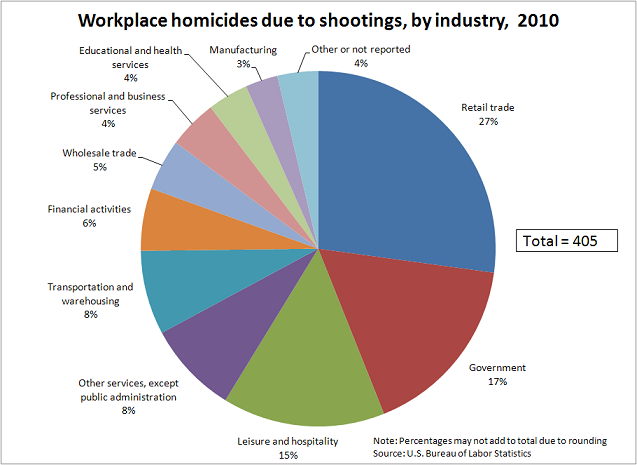An official website of the United States government
 United States Department of Labor
United States Department of Labor
Recent tragedies around the country have focused attention on workplace violence in the United States. The Census of Fatal Occupational Injuries (CFOI) conducted by the Bureau of Labor Statistics (BLS) provides an annual count of fatal work injuries in the United States, including homicides. From 2006 to 2010, an average of 551 workers per year were killed as a result of work-related homicides. In 2010 (the last year for which final data are available), CFOI reported a total of 518 workplace homicides, or 11 percent of all fatal work injuries that occurred that year. A total of 77 of those were multiple-fatality homicide incidents in which two or more workers were killed, including 69 homicides and 8 assailant suicides, all of whom were in work status at the time of the incident.
Shootings accounted for 78 percent of all workplace homicides in 2010 (405 fatal injuries). More than four-fifths (83 percent) of these workplace homicides from shootings occurred in the private sector, while only 17 percent of such shootings occurred in government. Workplace homicides attributed to shootings involving workers in elementary and secondary schools are relatively uncommon, although 12 were reported between 2006 and 2010. Of the 405 workplace shooting victims in 2010, 110 (or 27 percent) occurred in the retail trade industry. 1 Workplace shooting events account for only a small portion of nonfatal workplace injuries. In 2010, there were 500 nonfatal shootings with days away from work, which was a small fraction of the 1.2 million total nonfatal cases with days away from work reported in that year.
About 4 out of every 5 workplace homicide victims in 2010 were men. The type of assailants in these cases differed, depending on whether the victim was a man or a woman. Robbers and other assailants accounted for 72 percent of homicides to men, for example, and only 37 percent of homicides to women. A substantial difference exists when relatives and other personal acquaintances are the assailants: only 3 percent of homicides to men, but 39 percent to women. Assailants with no known personal relationship to their victims accounted for about two-thirds of workplace homicides. 2

U.S. Bureau of Labor Statistics, Census of Fatal Occupational Injuries.
1 For more information, see Joyce Northwood, “Assaults and Violent Acts in the Private Retail Trade Sector, 2003—2008,” Compensation and Working Conditions Online, December 2011, https://www.bls.gov/opub/mlr/cwc/assaults-and-violent-acts-in-the-private-retail-trade-sector-20032008.pdf
2 For more detailed information on workplace homicides with assailants and circumstance, see “Occupational homicides by selected characteristics, 1997–2010,” https://www.bls.gov/iif/factsheets/archive/workplace-homicides-1997-2010.pdf.
Last Modified Date: September 16, 2015